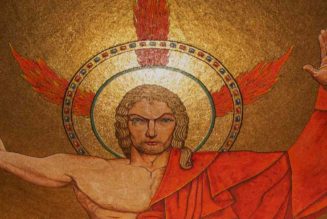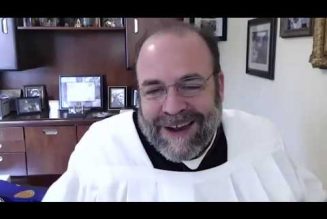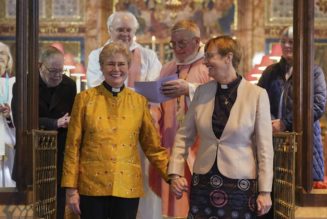By DONAL ANTHONY FOLEY
October is the month traditionally dedicated to the Holy Rosary, a devout practice, which according to tradition, originated at the time of St. Dominic (1170-1221). Like many traditional beliefs, this position has come in for criticism, but it does seem to be well-founded once we look at the history of the saint. And it is such a constant and firm tradition in the Church, and one supported by such great authority, that to question it is really to be unreasonable.
Rather as is the case with the early life of our Lady, the early history of the rosary devotion is shrouded in mystery; but the historical evidence we do have indicates that it arose as a result of the immense problems that the Albigensian heresy was causing the Church and society during St. Dominic’s lifetime.
According to tradition, the Blessed Virgin appeared to him, and told him that his preaching against the heretics was not bearing fruit because it had not been “watered with the dew of divine grace,” that is through the Angelic Salutation, the message given by the Angel Gabriel to Mary which comprises the first part of the Hail Mary.
She therefore advised him to preach her Psalter, that is, the rosary made up of 150 Angelic Salutations and 15 Our Fathers, and then he would reap an abundant harvest. The reference to the Psalter is to the 150 biblical Psalms. Once St. Dominic started to do that, it is asserted that he began to reap immense spiritual benefits amongst those whom he preached to.
This belief in a particular revelation from the Blessed Virgin cannot be tied down to a particular time or place, but the traditions supporting it are very strong. It is true that it isn’t mentioned in the early biographies of St. Dominic, but these are very incomplete; and just as the Gospels do not tell us everything we would like to know about the life of Christ, so there are gaps in what we know about St. Dominic.
The essence of the rosary devotion consists in reciting a particular number of Hail Marys while meditating on the life of Christ, and it noteworthy that it is just at the time of St. Dominic that recitation of the Angelic Salutation became popular in the Church. Prior to this, the emphasis had been more on praying the Our Father and the Creed.
And the Hail Mary, with its focus on the Incarnation of Christ, was a prayer particularly suited to combat the heretical beliefs of the Albigenses, since a denial of the Incarnation, the fact that Christ had really become man, was one of their most serious errors.
Despite the exertions of the saint, though, and the great good that he did in preaching the rosary, there was a general religious decline after his time, and it was left to the Dominican, Alan de la Roche, to revive the devotion in the latter half of the fifteenth century. And from that point on it became more and more firmly established in the Church.
Even before that, though, the practice of saying the rosary had not by any means died out, and there is a record dating from 1440 in the statues of Eton College, which was founded by Henry VI, that the scholars were required to pray daily the “complete Psalter of the Blessed Virgin, containing a Credo, fifteen Paters, and one hundred and fifty Ave Marias.”
According to tradition, too, St. Dominic preached the rosary in Rome, and in fact, according to a Bull of Pope Clement VIII, which was published in 1602, the Confraternity of the Rosary was first erected in the church of St. Sixtus in that city by the saint himself. And we have corroboration of this in the fact that there is a will dating from 1221, in which there is a reference to a Confraternity of the Rosary being founded by the saint in Spain.
Numerous Popes have supported the tradition that St. Dominic was indeed the founder of the rosary devotion, and in particular it is worth noting that the very learned Pope, Benedict XIV, who made a particular investigation of the history of the tradition, was a strong advocate of it.
A Stunning Victory
And in the nineteenth century, Pope Leo XIII, when recommending, and indeed commanding, that October should be observed as the month of the rosary, had very strong words to say about this tradition in his encyclical, Supremi Apostolatus Officio, “On Devotion of the Rosary.”
He began by recalling the terrible depredations caused by the Albigensian heretics in the south of France in the early thirteenth century, and the violence by which they spread their beliefs, and then stated that God had raised up St. Dominic and his Order to combat them, not by force of arms but through the devotion of the holy rosary, “which was disseminated through the length and breadth of the earth by him and his pupils.”
The result was the beginning of the end of Albigensianism and a wonderful example of the power of the rosary.
One of the most decisive incidents in the struggle against the Albigensians was the Battle of Muret, which took place on September 12, 1213 about 15 miles south of Toulouse in southern France. It marked the final major battle of the Albigensian Crusade, and involved a small force of Crusaders and Knights commanded by Simon de Montfort against much superior pro-Albigensian forces.
While those in the nearby fortress prayed with great fervor, St. Dominic is said to have appeared on the battlefield holding aloft a crucifix to encourage the soldiers, and the final result was a stunning victory for De Montfort’s forces. As a result, what is said to have been the first chapel ever dedicated to the rosary was built in thanksgiving by De Montfort in the church of St. James at Muret.
The Culture Of Death
Just over seven hundred years later, in 1917, our Lady appeared at Fatima and proclaimed her message of peace to the young shepherds. During her final apparition in October 1917 she described herself as the Lady of the Rosary, and prior to that she had repeatedly called for the daily recitation of the rosary as a way of bringing peace to the world and the Triumph of her Immaculate Heart.
We are now in the month of October, the month of the great miracle of the sun which set the seal on the events at Fatima, and also the month dedicated to the rosary. And in fact while the immense crowd in the Cova da Iria saw the solar miracle, the seers saw a tableau of visions of the Holy Family representing the mysteries of the rosary, further emphasizing its importance.
And just as Albigensianism, the “culture of death” of its day, was ultimately defeated through the power of the rosary as preached by St Dominic, so the modern culture of death, emanating now from the “errors of Russia” which the Blessed Virgin spoke about during the July apparition, will also be defeated when enough Catholics take up the spiritual arms given us by our Lady, in union with a genuine devotion to her Immaculate Heart.
It is incumbent on us, then, to focus again on praying the rosary daily, and praying it with real devotion, so as to play our part in bringing about a much needed peace, not only for the world at large, but also for our homes and communities.
- + + (Donal Anthony Foley is the author of a number of books on Marian Apparitions, and maintains a related website at www.theotokos.org.uk. He has also written two time-travel/adventure books for young people, and the third in the series is due to be published next year — details can be seen at: http://glaston-chronicles.co.uk.)










